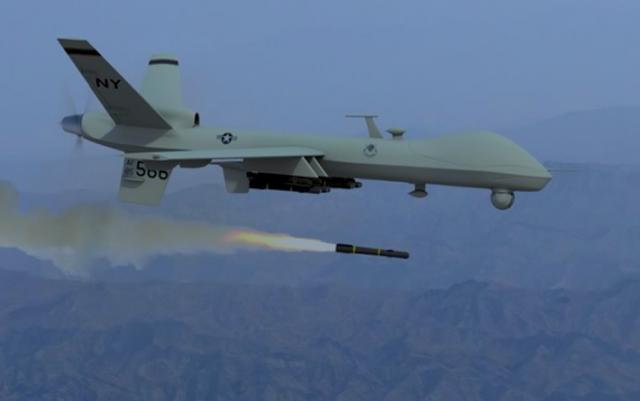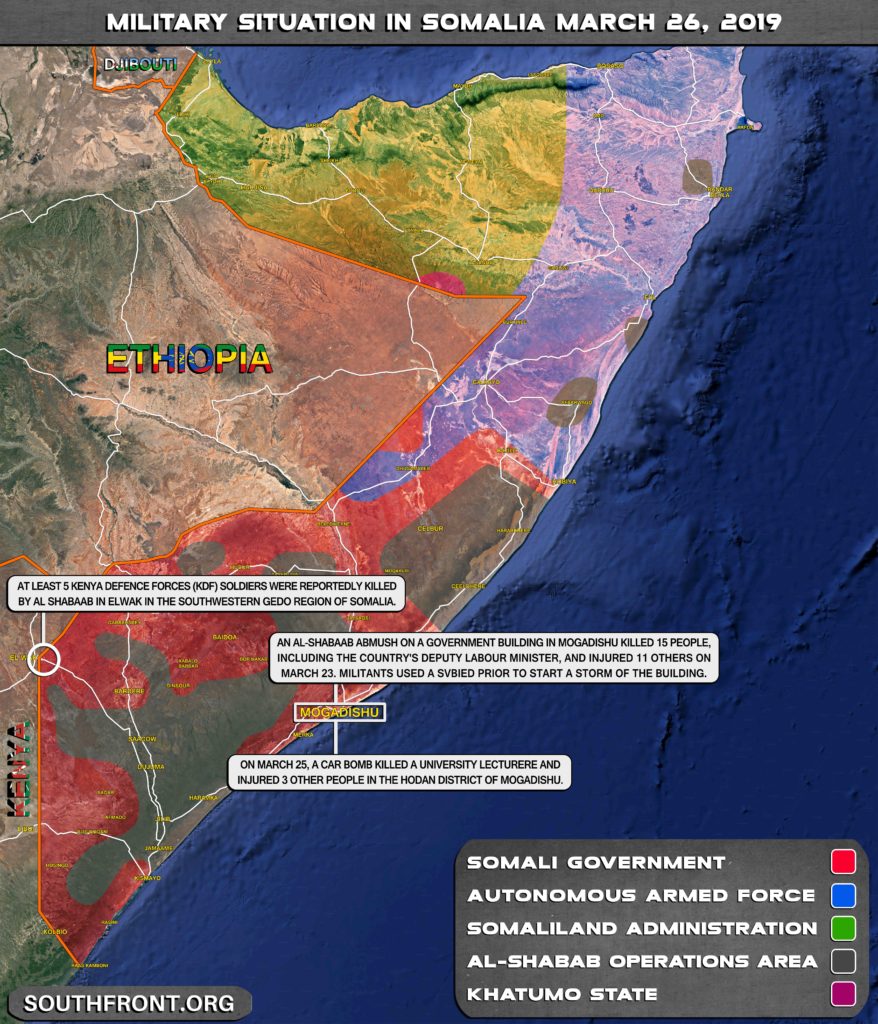In 2019, the US mission in Somalia has stepped up its airstrike activity in the country. Despite that, the aim of the US presence is the training of a local specialized infantry by US contractors and troops, AFRICOM claimed.
Somalia’s Danab Advanced Infantry Brigade (Lightning Force) is the Pentagon’s main objective in Somalia, according to Gen. Thomas D. Waldhauser, AFRICOM commander.
The Danab troops are initially trained by a private security company – Bancroft Global Development.
“As part of a broader international effort, Bancroft Global Development provides a package of mentoring services to the African Union Mission to Somalia (AMISOM), and through AMISOM to the Somali government,” the company’s website says.
After that the US troops continue their “grooming.”
“Currently, the recruitment and basic training for the Danab Brigade is provided through a Department of State administered cooperative agreement with Bancroft Global Development,” an unnamed State Department official was cited by Military Times. “This training prepares the forces for follow-on training and mentorship provided by U.S. military forces.”
Roughly 5 years ago, Danab started as a 150-person unit, but the ultimate aim is for it to become a 3,000-member force spread across each of the 6 Somali National Army sectors.
New batch of #US-trained Danab commandos graduated from #Baledogle military airbase in Lower Shabelle. #Somalia pic.twitter.com/7ywuWuliVz
— Abdirisak Tuuryare (@Tuuryare_Africa) March 20, 2016
The unit will report to a brigade headquarters at Baledogle Airfield — a former Soviet air base in southern Somalia. In September 2018, $12 million was delegated for “emergency runway repairs” at Camp Baledogle.
“Yes, AFRICOM operates out of Baledogle alongside our African partners,” Maj. Karl Weist, an AFRICOM spokesman, confirmed in an emailed statement. “The command has a variety of platforms that can operate out of that location in support of missions designed to promote security and stability in the region.”
“I’ll add that we will continue to work with our partners to support AMISOM and the federal government of Somalia in its effort to bring improved governance, development and stability,” Weist said. “Our strategy in East Africa is to enhance partner capability to ensure that violent extremist organizations, who wish harm in the region, are contained.”
General Thomas D. Waldhauser, AFRICOM commander said that the new Danab forces are recruited and trained with tribal and clan considerations in mind.
“We’ve learned the importance of factoring in cultural and region-specific considerations,” Waldhauser said in a statement. “We work closely with our Somali partners ensuring the composition of specific Danab companies is appropriate for the security sector where they’ll be employed.”
AFRICOM also said that there were no considerations of “dual loyalties” and that trained Danab forces may defect to reinforce some of the local “warlords.”
AFRICOM, the Somali government and its various regional governments “go to great lengths to ensure the individuals selected for the Danab are clan- and region-appropriate,” Maj. Karl Wies said, cited by Military Times.
“At this time, the indications we’ve received on the ground are that the Somali people hold the Danab in the highest esteem as a result of these efforts,” Wiest said. “Ultimately, the Danab as a unit fall under the central Somali government and we have no indications of dual loyalty.”
Furthermore, according to AFRICOM, operations against al-Shabaab were Somali-led. The US operation in Somalia began in 2001.
The US started hunting al-Shabaab, a local Somali insurgent group, with ties to al Qaeda. This therefore made them targets under the 2001 Authorisation for the Use of Military Force Act. According to the US, al-Shabaab wasn’t specifically targeted, even though Qaeda leader Ayman al Zawahiri announcing on February 9th, 2012 that al-Shabaab had formally become a franchise of al Qaeda.
In 2014, the frequency of US attacks in Somalia increased as the US started providing African peace keepers air support, targeting al Shabaab fighters who threatened the African troops and their US advisors.
Air and/or drone strikes in Somalia are a common occurrence currently.
The most recent confirmed air or drone strike took place on March 18th, 2019 and left 3 militants killed, as well as between 0-4 civilians. The strike took place in Awdheegle in the lower Shabelle region, according to the AFRICOM statement.
The Bureau of Investigative Journalism posted a report, which contains information regarding confirmed airstrikes back to 2007, and a sharp increased can be seen between 2014 and 2015, with it ramping up even more between 2016 and 2017.

The overall number of confirmed airstrikes in 2018 was 45, with between 331-335 killed, and a maximum number of confirmed civilian casualties sitting at 9.
A significant ramp-up can be observed in 2019, with 28 airstrikes just in the first quarter of the year. The death toll also sits at between 249-259, with approximately 6 civilians killed.
Other operations for 2017 and 2018 sat at 3 each – the ones in 2017 left 19 dead, while the ones in 2018 – 11. But it should be noted that those operations left around 10 and 5 civilians dead, respectively. Thus, non-airstrike operations have about a 50% death toll of civilians.
In general, the Pentagon’s Joint Special Operations Command (JSOC) leads the US covert war on terror in Somalia. In addition, the CIA also has a strong presence in the Horn of Africa.
Under Trump, the Pentagon increased airstrikes and ground troops in Somalia, where approximately 500 U.S. personnel are based, including troops, civilians and contractors.
Elite troops from the Pentagon’s JSOC are routinely deployed on the ground for surveillance, reconnaissance, and assault and capture operations. In June 2011, the US began carrying out drone strikes in Somalia. JSOC has its own fleet of armed Reaper drones, which are flown from various bases in the region.
The CIA also operates a secret base at Mogadishu airport, according to a detailed investigation by Jeremy Scahill at The Nation. Unarmed US surveillance drones also regularly fly from the airport, according to a well-informed Bureau source. While some of these are part of the US ‘war on terror’, many provide support for peacekeeping operations in the region.
In addition to militant activity, both Kenya and Ethiopia have also invaded parts of Somalia, with the former also doing it with alleged US support.
On January 4th, 2019, reports surfaced of the Pentagon’s plan to cut troops and the number of airstrikes in Somalia. The Hill cited two unnamed senior US officials who claimed that the administration has assessed that al-Shabab didn’t pose a direct danger to the United States as American forces have killed many of the group’s senior operatives.
Under the new alleged plan, the CIA would take the lead for bombing militants in Somalia.
On January 7th, the Pentagon denied the reports. Pentagon spokeswoman Navy Commander Candice Tresch told VOA:
“There have been no recent policy changes regarding U.S. operations in Somalia. We continue to support the Federal Government of Somalia’s efforts to degrade al-Shabab.”
According to US military officials say there were estimated between 3,000 to 7,000 al-Shabab fighters and 70 to 250 ISIS-Somalia fighters in Somalia as of August 2018.
In terms of funding for the Somalia operation, the Pentagon’s Budget Request for Fiscal Year 2020 doesn’t specify any numbers for the country separately.
The budget requested $46 billion for in-theater support for Overseas Contingency Operations, under which the Combined Joint Task Force-Horn of Africa (CJTF-HOA) falls.








More covert wars that will come to bite the US’s arse in the future. Like they always do.
Not exactly a covert war, when the bombings are major ground actions are openly discussed with the press. But that map doesn’t even scratch the surface with the mayhem of tribal states in Somalia, so any war is bound to be complicated and the details will remain classified until the war is over.
I met an ex-marine who talked about Somalia once. He was stationed at an airfield that was nothing to speak of, just enough runway on a beach for a C-5 to land. The worst thing that happened that he saw was that a pack of wild dogs ran into the runway and got sucked into a C-5’s engines, cost millions in repairs. This marine was one of a team that would go out and teach friendly militias how to fight, just the basics because these militiamen generally had less knowledge of how to use weapons than even lay people in the developed world. They also showed all the signs of food shortages, because there was a famine in that area, so this marine and his buddy would over report how many MREs they needed, so they could give the extra stuff to their friends. He said the guys in intelligence had all sorts of stories about the local drama in the world of piracy and revenge murder, but it never made any headlines because no Americans were getting hurt.